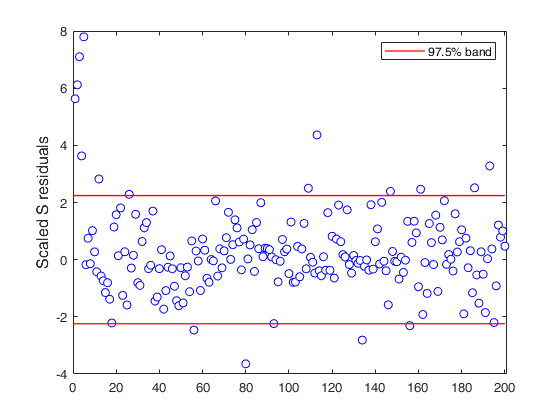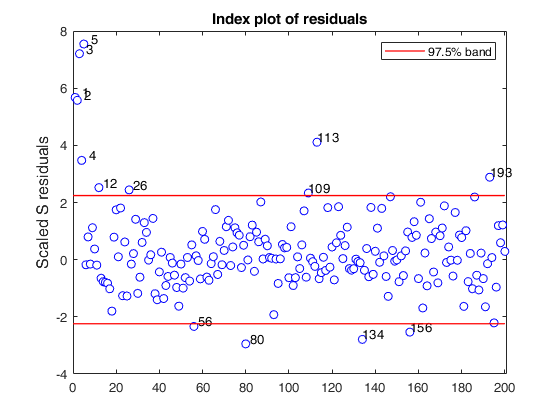Sreg
Sreg computes S estimators in linear regression.
Description
Examples
 Sreg with all default options.
Sreg with all default options.
 Sreg with all default options.
Sreg with all default options.Run this code to see the output shown in the help file.
n=200;
p=3;
rng(123456);
X=randn(n,p);
% Uncontaminated data.
y=randn(n,1);
% Contaminated data.
ycont=y;
ycont(1:5)=ycont(1:5)+6;
[out]=Sreg(ycont,X);
laby='Scaled S residuals';
titl='';
resindexplot(out.residuals,'title',titl,'laby',laby,'numlab','')
Total estimated time to complete S estimate: 1.44 seconds

Sreg with optimal rho function.
n=200;
p=3;
rng(123456);
X=randn(n,p);
% Uncontaminated data.
y=randn(n,1);
% Contaminated data.
ycont=y;
ycont(1:5)=ycont(1:5)+6;
[out]=Sreg(ycont,X,'rhofunc','optimal');
Input Arguments
y — Response variable.
Vector.
A vector with n elements that contains the response variable. y can be either a row or a column vector.
Data Types: single| double
X — Data matrix of explanatory variables (also called 'regressors') of
dimension (n x p-1).
Rows of X represent observations, and columns
represent variables.
Missing values (NaN's) and infinite values (Inf's) are allowed, since observations (rows) with missing or infinite values will automatically be excluded from the computations.
Data Types: single| double
Name-Value Pair Arguments
Specify optional comma-separated pairs of Name,Value arguments.
Name is the argument name and Value
is the corresponding value. Name must appear
inside single quotes (' ').
You can specify several name and value pair arguments in any order as
Name1,Value1,...,NameN,ValueN.
'bdp',0.4
, 'bestr',10
, 'conflev',0.99
, 'intercept',false
, 'minsctol',1e-7
, 'msg',false
, 'nocheck',true
, 'nsamp',1000
, 'refsteps',10
, 'refstepsbestr',10
, 'reftol',1e-05
, 'reftolbestr',1e-10
, 'rhofunc','optimal'
, 'rhofuncparam',5
, 'yxsave',1
, 'plots',0
bdp
—breakdown point.scalar.
It measures the fraction of outliers the algorithm should resist. In this case, any value greater than 0, but smaller or equal than 0.5 will do fine.
Note that given bdp nominal, efficiency is automatically determined.
Example: 'bdp',0.4
Data Types: double
bestr
—number of "best betas" to remember.scalar.
Scalar defining number of "best betas" to remember from the subsamples.
These will be later iterated until convergence (default=5).
Example: 'bestr',10
Data Types: single | double
conflev
—Confidence level that is
used to declare units as outliers.scalar.
Usually conflev=0.95, 0.975 0.99 (individual alpha) or 1-0.05/n, 1-0.025/n, 1-0.01/n (simultaneous alpha).
Default value is 0.975
Example: 'conflev',0.99
Data Types: double
intercept
—Indicator for constant term.true (default) | false.
Indicator for the constant term (intercept) in the fit, specified as the comma-separated pair consisting of 'Intercept' and either true to include or false to remove the constant term from the model.
Example: 'intercept',false
Data Types: boolean
minsctol
—tolerance for the iterative
procedure for finding the minimum value of the scale.scalar.
Value of tolerance for the iterative procedure for finding the minimum value of the scale for each subset and each of the best subsets (It is used by subroutine minscale.m).
The default value is 1e-7;
Example: 'minsctol',1e-7
Data Types: single | double
msg
—Level of output to display.boolean.
It controls whether to display or not messages on the screen.
If msg==true (default) messages are displayed on the screen about estimated time to compute the estimator and the warnings about 'MATLAB:rankDeficientMatrix', 'MATLAB:singularMatrix' and 'MATLAB:nearlySingularMatrix' are set to off.
If msg is false, no message is displayed on the screen.
Example: 'msg',false
Data Types: logical
nocheck
—Check input arguments.boolean.
If nocheck is equal to true, no check is performed on matrix y and matrix X. Notice that y and X are left unchanged. In other words, the additional column of ones for the intercept is not added.
As default nocheck=false.
Example: 'nocheck',true
Data Types: logical
nsamp
—Number of subsamples that will be extracted to find the
robust estimator.scalar.
If nsamp=0, all subsets will be extracted.
They will be (n choose p).
If the number of all possible subset is <1000 the default is to extract all subsets otherwise just 1000.
Example: 'nsamp',1000
Data Types: single | double
refsteps
—Number of refining iterations.scalar.
Number of refining iterations in each subsample (default = 3).
refsteps = 0 means "raw-subsampling" without iterations.
Example: 'refsteps',10
Data Types: single | double
refstepsbestr
—number of refining iterations for each best subset.scalar.
Scalar defining number of refining iterations for each best subset (default = 50).
Example: 'refstepsbestr',10
Data Types: single | double
reftol
—tolerance for the refining steps.scalar.
The default value is 1e-6;
Example: 'reftol',1e-05
Data Types: single | double
reftolbestr
—Tolerance for the refining steps.scalar.
Tolerance for the refining steps for each of the best subsets.
The default value is 1e-8;
Example: 'reftolbestr',1e-10
Data Types: single | double
rhofunc
—rho function.string.
String that specifies the rho function which must be used to weight the residuals.
Possible values are: 'bisquare';
'optimal';
'hyperbolic';
'hampel';
'mdpd';
'AS'.
'bisquare' uses Tukey's and \psi functions.
See TBrho and TBpsi.
'optimal' uses optimal \rho and \psi functions.
See OPTrho and OPTpsi.
'hyperbolic' uses hyperbolic \rho and \psi functions.
See HYPrho and HYPpsi.
'hampel' uses Hampel \rho and \psi functions.
See HArho and HApsi.
'mdpd' uses Minimum Density Power Divergence \rho and \psi functions.
'AS' uses Andrew's sine \rho and \psi functions.
The default is bisquare.
Example: 'rhofunc','optimal'
Data Types: character
rhofuncparam
—Additional parameters for the specified rho function.scalar | vector.
For hyperbolic rho function it is possible to set up the value of k = sup CVC (the default value of k is 4.5).
For Hampel rho function it is possible to define parameters a, b and c (the default values are a=2, b=4, c=8).
Example: 'rhofuncparam',5
Data Types: single | double
yxsave
—save option.scalar.
If yxsave is equal to 1, the response vector y and data matrix X are saved into the output structure out. Default is 0, i.e. no saving is done.
Example: 'yxsave',1
Data Types: double
plots
—Plot on the screen.scalar.
If plots = 1, generates a plot with the robust residuals against index number. The confidence level used to draw the confidence bands for the residuals is given by the input option conflev. If conflev is not specified a nominal 0.975 confidence interval will be used.
Example: 'plots',0
Data Types: single | double
Output Arguments
out — description
Structure
A structure containing the following fields
| Value | Description |
|---|---|
beta |
vector containing the S estimator of regression coefficients. |
scale |
scalar containing the estimate of the scale (sigma). This is the value of the objective function. |
bs |
p x 1 vector containing the units forming best subset associated with S estimate of regression coefficient. |
residuals |
n x 1 vector containing the estimates of the robust scaled residuals. |
fittedvalues |
n x 1 vector containing the fitted values. |
outliers |
this output is present only if conflev has been specified. It is a vector containing the list of the units declared as outliers using confidence level specified in input scalar conflev. |
conflev |
confidence level that is used to declare outliers. Remark: scalar out.conflev will be used to draw the horizontal line (confidence band) in the plot. |
singsub |
Number of subsets without full rank. Notice that out.singsub > 0.1*(number of subsamples) produces a warning. |
weights |
n x 1 vector containing the estimates of the weights. |
rhofunc |
string identifying the rho function that has been used. |
rhofuncparam |
vector that contains the additional parameters for the specified rho function which have been used. For hyperbolic rho function the value of k=sup CVC. For Hampel rho function the parameters a, b and c. If input option argument 'rhofunc' is not 'hyperbolic' or 'hampel' this field is empty. |
y |
response vector Y. The field is present only if option yxsave is set to 1. |
X |
data matrix X. The field is present only if option yxsave is set to 1. |
class |
'Sreg' |
References
Maronna, R.A., Martin D. and Yohai V.J. (2006), "Robust Statistics, Theory and Methods", Wiley, New York.
Acknowledgements
This function follows the lines of MATLAB/R code developed during the years by many authors.
For more details see the R library robustbase http://robustbase.r-forge.r-project.org/ The core of these routines, e.g. the resampling approach, however, has been completely redesigned, with considerable increase of the computational performance.
